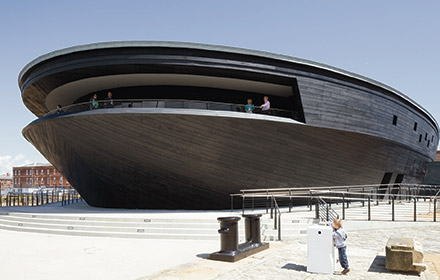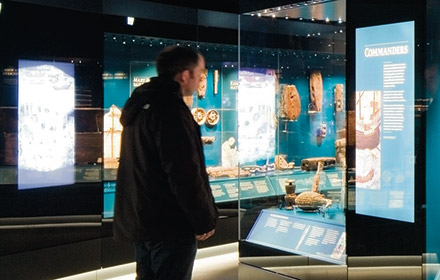NEC Display Solutions Client Installation Leisure
MARY ROSE MUSEUM
BRINGING HISTORY TO LIFE AT THE TOUCH OF A SCREEN
A new museum, purpose-built around the hull of England’s most famous warship, tells the story of her crew through interactive audio visual presentations. Bringing history to life, NEC displays with through-glass touch foil screens enable visitors to discover the context surrounding the artefacts found on board the Mary Rose, presenting a highly visual tableau of life in Tudor times.
The Mary Rose, flagship of King Henry VIII’s Tudor fleet capsized and sank in 1545 whilst attacking the French fleet, just off the coast of Portsmouth, with the loss of around 500 crew. The hull, or at least one remaining side of it, was rediscovered in 1971 having been preserved by layers of silt and clay over four centuries. Salvaged in 1982 along with 19,000 artefacts it was transferred to a temporary building in the Portsmouth Historic Dockyard. “The Mary Rose is one of the most important objects in English History. It’s up there with the doomsday book, the Magna Carta, and Hampton Court,” said eminent historian David Starkey, “Indeed I would go further. The Mary Rose is the English Pompeii or Herculaneum; all Tudor life is there.”
Since being recovered the hull has undergone a period of conservation involving the continuous spraying of water and then a soluble wax, the latter stages of which required a glass screen and plastic sheeting around the hull, largely obscuring the view of 8 million visitors to the temporary Ship Hall up to the point of closure in 2009. A new £27million purpose-built museum and visitor centre was then constructed around the hull and officially opened in May 2013, coinciding with the final cessation of the final phase of conservation, the air drying.

The Challenge
The new building, externally designed by Wilkinson Eyre Architects and internally by Pringle Brandon Perkins+Will, protects the hull whilst allowing the essential conservation work to continue. It also houses several thousand of the artefacts including numerous personal items, cannon, ship’s provisions and working items and hundreds of bows and arrows. The role of the museum is, as Nick Butterley, explains: “To tell the story of how the ship operated, the conditions of life onboard and the tragic way in which the crew died when the ship capsized, many of whose bones have been recovered, along with those of a dog, affectionately named Hatch, whose skeleton was recovered and is now on display.”
All the items originated from the same place and most are instantly recognisable. Nick: “The Mary Rose story is best told through pictures and sound, rather than text. Our objective was to place the items in context and to show how they were used, rather than to have lengthy text labels on every item that we felt would be a distraction. We want to let the artefacts speak for themselves but also offer a means for visitors to explore the history of the vessel more deeply so video presentations and touch screens are available throughout the museum to provide general and more detailed information.”
Unusually for a museum, only short descriptive labels are included within the cases itemising and detailing the pieces. “The museum uses a concept of ‘unlocking the glass case’ with video sequences of actors dressed in period costume using these objects shown on integral touchscreens within the cases,” explains Peter Higgins creative director at Land Design Studio. “These character cases provide a very simple way of setting the context of the artefacts as they would be used in their work or for leisure as well as providing deeper levels of information through interactivity .”

The NEC Solution
NEC 42” LCD monitors with VIP through-glass touch foil screens are set within the cabinets to provide this capability. “The monitors are set within the environmentally-controlled cabinets which required extensive temperature testing on each cabinet to ensure that the internal air conditioning could cope with the potential heat from the monitors. The result is an extremely clean look to the high-tech cabinets, the screens themselves are not noticeable, just the content, which is the effect that the museum required,” explains Hugo Roche, managing director of Sysco, the museum’s AV integrator. “Having worked successfully with NEC in the past, we chose to use a trusted product which has been tried and tested. NEC’s robust displays are designed for heavy duty operation with advanced heat management capability and with heat build-up being a potential issue, we needed a professional solution.”
Problems of parallax resulting from the gap between the monitor surface and the touch foil have been overcome by individually registering each touch foil with its monitor according to its height and position, resulting in fast and accurate touch response, which as Nick comments: “is absolutely necessary to keep the attention of the younger generation who are used to this type of interaction and can easily become bored and inattentive if it fails to deliver.”
The entire AV system is controlled by a Crestron system over a standard network. “This minimises disruption to visitors and allows us to monitor the whole system from a single point,” says Hugo Roche. “Firmware updates and content refreshing can be done simply across the whole estate of more than 40 display points.”
The Result
The overall result is a museum that successfully blends history with modern technology to present it to the public as well as continuing to provide the best possible care for future generations. “The brief at the start of the project was to enhance and tell the story of the Mary Rose, which has been achieved through a mixture of elements,” comments Nick Butterley. “We believe that we have succeeded in creating a building and maintaining an exhibition that is truly world class, enabling us to show off the Mary Rose and her artefacts in all her glory, whilst continuing to preserve this fascinating and unique part of maritime history. Together, the collection provides the world with its finest insight into life 500 years ago.

